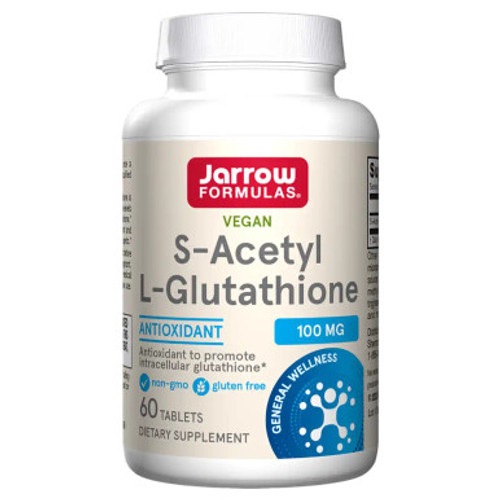S-Acetyl Glutathione by Xymogen
S-Acetyl Glutathione by Xymogen is a detox supplement designed with a specialized acetylated variant of glutathione for the best absorption.* As such, it may stand out among similar products due to its efficacy—it’s a product you may want to consider.*
Who May Take S-Acetyl Glutathione by Xymogen?
S-Acetyl Glutathione may be for you if:
- you smoke cigarettes or drink a lot of alcohol*
- you live in highly polluted areas*
- you’re over 40*
- you want to support your immune response*
S-Acetyl Glutathione by Xymogen—Potential Health Benefits
S-Acetyl Glutathione by Xymogen may support:
- anti-oxidation*
- cell function and healthy aging*
- detoxification*
- immune response*
- amino acid transport across cell membranes*
Supplements support your health but do not replace a balanced diet. Always check with your healthcare practitioner if you have doubts about a new supplement. Book a FREE product consultation to learn more about this supplement.
Recommendation:
Xymogen suggests taking one to two capsules 1 to 2 times a day, or as recommended by your healthcare professional.
Serving Size: 2 capsules
Servings Per Container: 30 or 60
Amount Per Serving:
S-Acetyl Glutathione 200 mg
Other Ingredients: Acid-resistant capsule (hypromellose, gellan gum, and water), microcrystalline cellulose, stearic acid, magnesium stearate, and silica.
Does Not Contain: Wheat, gluten, corn, yeast, soy, animal and dairy products, fish, shellfish, peanuts, tree nuts, egg, sesame, ingredients derived from genetically modified organisms (GMOs), artificial colors, artificial sweeteners, and artificial preservatives.
Caution: Consult your healthcare professional prior to use. Individuals taking medication should discuss potential interactions with their healthcare professional. Do not use if tamper seal is damaged.
Storage: Keep closed in a cool, dry place out of reach of children.
LEGAL NOTICE: Xymogen's Exclusive Professional Formulas are available through select licensed health care professionals. The Internet Sale and Discounting of XYMOGEN formulas are strictly prohibited.
References:
- Locigno, R., Pincemail, J., Henno, A., et al. (2002). S-Acetyl-glutathione selectively induces apoptosis in human lymphoma cells through a GSH-independent mechanism. International Journal of Oncology, 20(1), 69–75. https://doi.org/10.3892/ijo.20.1.69
- Lomaestro, B. M., & Malone, M. (1995). Glutathione in health and disease: Pharmacotherapeutic issues. Annals of Pharmacotherapy, 29(12), 1263–1273. https://doi.org/10.1177/106002809502901205
- Cacciatore, I., Cornacchia, C., Pinnen, F., et al. (2010). Prodrug approach for increasing cellular glutathione levels. Molecules, 15(3), 1242–1264. https://doi.org/10.3390/molecules15031242
- Vogel, J., Cinatl, J., Dauletbaev, N., et al. (2005). Effects of S-acetylglutathione in cell and animal models of herpes simplex virus type 1 infection. Medical Microbiology and Immunology, 194(1–2), 55–59. https://doi.org/10.1007/s00430-003-0215-2
- Ballatori, N., Krance, S. M., Notenboom, S., et al. (2009). Glutathione dysregulation and the etiology and progression of human diseases. Biological Chemistry, 390(3), 191–214. https://doi.org/10.1515/BC.2009.033
- Richman, P. G., & Meister, A. (1975). Regulation of gamma-glutamyl-cysteine synthetase by nonallosteric feedback inhibition by glutathione. Journal of Biological Chemistry, 250(4), 1422–1426. https://doi.org/10.1016/S0021-9258(19)41799-5
- Anderson, M. E., Powrie, F., Puri, R. N., et al. (1985). Glutathione monoethyl ester: Preparation, uptake by tissues, and conversion to glutathione. Archives of Biochemistry and Biophysics, 239(2), 538–548. https://doi.org/10.1016/0003-9861(85)90289-6
- Anderson, M. E., Nilsson, M., & Sims, N. R. (2004). Glutathione monoethyl ester prevents mitochondrial glutathione depletion during focal cerebral ischemia. Neurochemistry International, 44(3), 153–159. https://doi.org/10.1016/j.neuint.2003.08.002
- Kretzschmar, M. (1996). Regulation of hepatic glutathione metabolism and its role in hepatotoxicity. Experimental and Toxicologic Pathology, 48(5), 439–446. https://doi.org/10.1016/S0940-2993(96)80073-6
- Fraternale, A., Paoletti, M. F., Casabianca, A., et al. (2006). Antiviral and immunomodulatory properties of new pro-glutathione (GSH) molecules. Current Medicinal Chemistry, 13(15), 1749–1755. https://doi.org/10.2174/092986706777935185
- Kretzschmar, M., & Klinger, W. (1990). The hepatic glutathione system—influences of xenobiotics. Experimental Pathology, 38(3), 145–164. https://doi.org/10.1016/S0940-2993(11)80031-3
- Donnerstag, B., Ohlenschlager, G., Cinatl, J., et al. (1996). Reduced glutathione and S-acetylglutathione as selective apoptosis-inducing agents in cancer therapy. Cancer Letters, 110(1–2), 63–70. https://doi.org/10.1016/S0304-3835(96)04474-9






